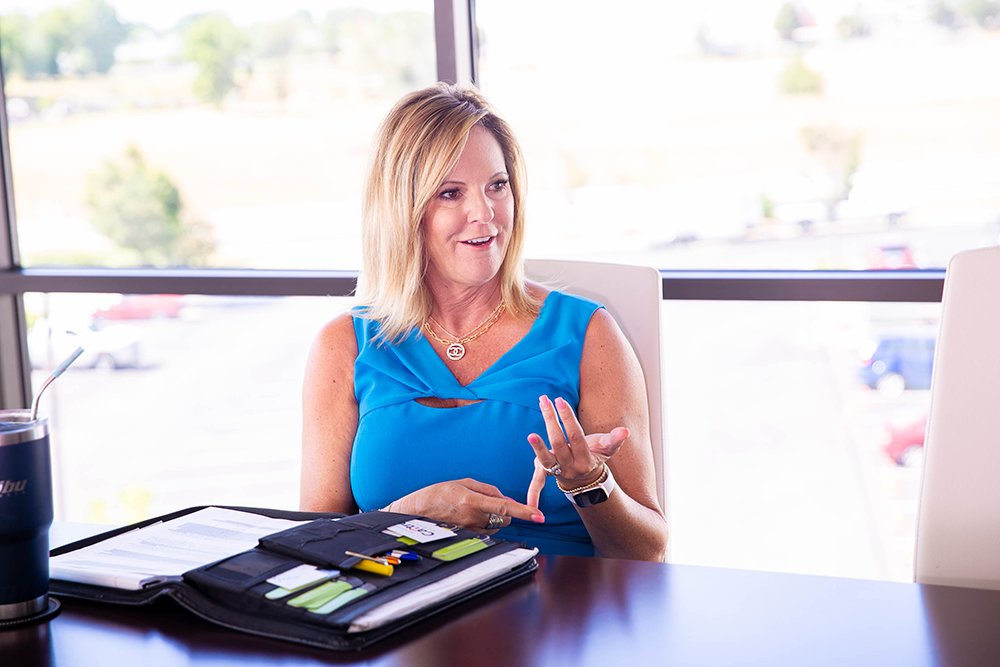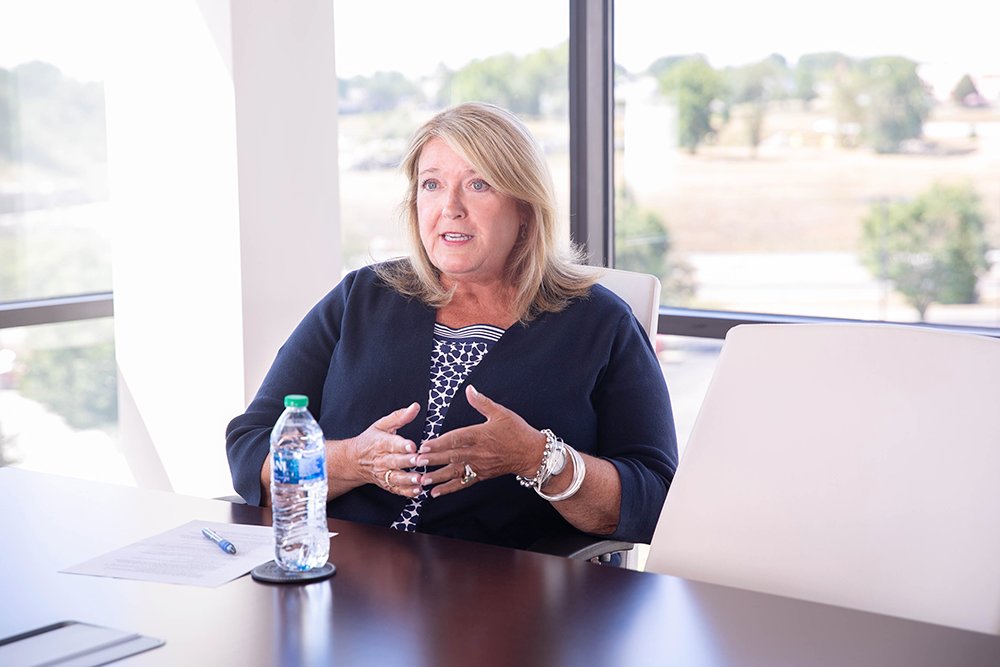YOUR BUSINESS AUTHORITY
Springfield, MO
YOUR BUSINESS AUTHORITY
Springfield, MO






Springfield Business Journal Executive Editor Christine Temple talks employee benefits with human resources professionals Sara Choate, managing director of KPM CPAs & Advisors' Human Capital Solutions; Karen Shannon, vice president of business consulting at Ollis/Akers/Arney; and Lynette Weatherford, president and adviser of HR Advantage Inc.
Christine Temple: This spring, the U.S. hit a record high of job openings: two jobs for every one job seeker. The pressure on employers for talent is undeniable. Can you characterize the market that we’re facing right now?
Karen Shannon: Something interesting I’m seeing is actually a competition from East and West coast employers. Traditionally, we’ve had to compete for talent locally and regionally. With COVID, employers are so much more comfortable even hitting 100% teleworking. So, we’re seeing East and West coast employers tap into our market. We’ve got awesome talent. We’ve got a great work ethic. We’ve historically had more moderate wages. They can pay up from what local employers are paying, but they’re saving a lot of money based on their own demographic areas.
Sara Choate: It is no longer a local market. It’s global. We’re really at a point of, to a certain extent, adapt or die. Years ago, I remember hearing if you were from the Midwest and you went to one of the coasts, you were looked upon very favorably in the job market because of all of those things you mentioned. We just have to be more creative and understand what we’re up against.
Shannon: I find so many employers a little more reluctant to do the same strategy and go after talent in other places because they’re not totally comfortable with 100% remote working. They’re more comfortable than they were three years ago, but we’ve got to implement some of the same interesting strategies to have good results as well.
Choate: Ultimately, there are just fewer people. There was an article that came out just this morning. It was an interview with the CEO of Microsoft, and he was citing some data from just the sheer numbers of people available in the workforce. He said from 1950 to 2015, approximately every five years, 5 million new people entered the workforce. From 2016 to 2020, that number went to 2 million. Just the numbers alone tell us we have a problem. I think you hear a lot of, oh, people are just lazy. They don’t want to work. I would disagree with that. There have always been people who don’t want to work. There’s a ready and willing workforce out there. It’s just quite simply the numbers are smaller.
Lynette Weatherford: This was predicted many years ago, pre-pandemic. This was because of the gap in the generations. The baby boomer generation is going to be opting out and we just have to prepare for it. Then COVID hit, and now there’s unreliable child care. The parents have really had to learn to adapt. If they’re finding remote work, then that’s most likely what they’re doing. My firm has been doing this for 17 years, as far as working remote, and I’m so grateful for it. It’s not just a matter of filling a vacancy. Who has the right seat on the bus and who can fill it? It’s really putting that strategy in.
Flexible workplaces
Temple: On remote and hybrid work, a study last month from McKinsey & Co. finds 58% of American workers can work from home at least one day a week, and 87% have some flexibility built into their role. Over two years into this pandemic, how are employers landing on that flexible and remote work environment these days? Is it here to stay?
Weatherford: I’ve seen most employers be a little bit more flexible than rigid. Back in the day, remote work was a little bit taboo. It’s a trust factor. We’ve really leaped over that and made some strong strides. But also with technology, there’s the tracking – as long as the job’s getting done and they’re not having complaints or issues. Obviously, that’s going to only be for some industries. You can’t do that in customer-facing positions or manufacturing.
Choate: I saw something the other day. It was a company that employed firefighters, but they also employed staff that can work remote. The firefighters are saying, we can’t work remote, so we want more – more pay, something extra – because we don’t have that flexibility. When you’re in the thick of it, it’s really difficult to say exactly what’s happening. In five years, we’ll know so much more. I’ve talked to some people and it almost feels like a modern-day worker uprising.
Weatherford: I think I’m hearing union.
Choate: It is certainly a more pro-union environment than it has been in many years. But even in those nonunion environments, people are saying I’m exhausted; I’m not willing to work like this any longer. You, company XYZ, figure out how my life can work around you, not the other way around.
Shannon: There’s more in flexibility than just teleworking. Those employees that are your director of first impression at the front desk that can’t perform their job remotely, there’s other ways to add flexibility into their work. I’m also seeing employers actually changing compensation structures for people that can’t work remotely. Let’s find other ways to integrate flexibility into your role or other types of total rewards that fit. Particularly when we had so many of the community shutdowns, there was hazard pay or differential pay for those that couldn’t work remotely.
Reengaging workers
Temple: Sounds like it’s that labor force participation rate that we really need to focus on with the tight job market. So, how can companies use benefits to entice people to work for their company or reenter the workforce? What benefits are most important to employees?
Weatherford: We have a division that does just solely recruitment. We’re seeing student loan payoffs, unlimited (paid time off), pet insurance. That’s just to name a few. It’s just things we haven’t had in the past. Sign-on bonuses that are crazy.
Temple: Like how much?
Weatherford: I have one that is, of course it’s a high-level position, but a $100,000 sign-on bonus plus a six-figure salary. Not uncommon.
Shannon: For millennials, flexibility not only in where they work but when they work. Millennials I think are doing a lot of things right and looking at what they want in life. They are not into the 8-5 job. So, flexibility in scheduling and having freedom is really desirable as people are recruiting. Then also career development and training. If you don’t have that internally, finding the resources externally to make that part of your total rewards package is really important. Competitive compensation, competitive benefits, is also still part of the total rewards package, but I find the flexibility issue and the career development are actually higher.
Choate: I think it comes down to health and happiness as far as what people are looking for. Generally, if somebody leaves and they tell you they’re leaving for compensation, it’s never really that. I can think of one conversation in my entire 20-year career where I went, OK, that was about compensation. When I say health, I don’t necessarily mean my physical health. That’s an element of it, but I think we’re seeing more and more mental health being such a big topic right now that’s in the workplace. As a leader, you’re seeing your people stressed out; you’re seeing them maxed out and saying, my mental health has suffered over the last two years. Of course it has. How can we support that need?
Weatherford: I agree. That’s a key word: support.
Choate: It’s a culture of wellness. For a long time, that meant put some treadmills in a room and we’ll call that wellness. We found out really fast that that didn’t work. There was no impact there. How can we help you live whatever your version of your best life is?
Shannon: In addition to the physical and mental well health, focusing on financial wellness. A lot of the strategies that we’re seeing and that we’re putting into place are around employee financial wellness. That can go back to the payoff of student loans, but also helping them budget. Different strategies to help them and their family make good financial decisions. The less stress you have around financial issues, it does impact emotional health, mental health and even physical health.
Choate: When things are out of whack at home, they’re going to be out of whack at work. And when things are out of whack at work, they’re going to be out of whack at home. In terms of benefits, really giving people true time away. Developing expectations and parameters around, you’re going to take a week off and you’re really going to take a week off. If you have a culture that makes people think the building will not be standing if you don’t check in every day for a week, then I think you need to do some looking inward.
Shannon: Another trend that I’m seeing are “workcations.” So it’s work/vacation. It’s giving people the opportunity to go someplace, whether it’s being near family or someplace they want to travel to. So part of it is vacation, but then also saying if you want to stay or they request an extra three weeks to work from Florida, to work from Denver, or family in Seattle, they are staying those extra three weeks and working remotely. It’s an issue of freedom and control that helps people.
Family leave
Temple: As we look at benefits, it seems they are all ratcheting up. One benefit that wasn’t increasing nationally is paid maternity leave. The Society of Human Resource Management found in 2022, 35% of employers surveyed offered this benefit compared with 53% in 2020, despite employees ranking it as a really important benefit. What are you seeing among your clients?
Shannon: I’ve actually seen the opposite. We’re adding more paternity leave. Paid leave for both parents. I’m seeing a trend that’s different from that, but maybe we haven’t caught up with that. More employers that we work with were implementing company-paid short-term disability and company-paid medical leave. Is that influencing the stats on the national level for paid maternity if they have other forms of pay replacement?
Choate: I would agree. Regionally, we’ve been a little slow to adopt to that particular benefit, so we’re trying to catch up.
Weatherford: It’s a matter of knowing your workforce, if they’re taking a poll and that’s not the most valuable to them or maybe they are enriching other areas. We only have eight states that require it as mandatory.
Evaluating policies
Temple: What are some of the unique or progressive policies you see on the horizon?
Choate: What’s most important as an employer – have you asked your people what they want? It’s one thing for the C-suite to make these decisions or for HR to make these decisions, but my goodness, you’re missing the boat if you’re not talking to your people. I think you’ll find even if you ask them and you find that you are aligned, just the fact that you ask them will help. Or maybe you’ll find that you’re terribly misaligned and you really thought they wanted pet insurance, but they don’t care about pet insurance. They really want short-term disability or they want more time off or they want to be able to unplug without getting five phone calls a week from their boss. If you haven’t done that, you have to start.
Shannon: Employers have to shift what we consider work. I’m seeing more millennials that want to work one or two years and then take a year off to travel Europe, backpack South America, but then come back and work another two years. People want to move to Denver and work remote there. We’ve got to change this concept of work from 8-5. I see also in millennials they have a lifestyle they want to maintain and they don’t want work to interfere with it. We all want that. But I think millennials do a great job of being vocal about what they want, and they do a much better job of trying to create life/work balance.
Choate: When we talk whether it’s millennials or Gen Z, quite frankly, if baby boomers had the opportunity to work the way that younger generations can work now, they absolutely would have.
Shannon: Other benefits that I’m seeing that are unique and different is unpaid time off. I’m seeing an increase in sabbaticals. I’m also seeing leave for miscarriages. There’s the physical healing and the emotional and mental healing as well.
Professional development
Temple: Karen, you mentioned the importance of professional development in younger workers. A SHRM study finds 78% of organizations pay for employees to develop new skills; that’s up since pre-pandemic as conferences are returning. What does professional development look like with your clients?
Shannon: We develop management curriculum and emerging leader curriculum for their employees that they want to support and really develop for that first supervisory role, as well as individual contributor development. It can be internally, externally (or) special projects. You mentioned conferences. I do a lot of conferences nationally and regionally, and they all started coming back in person in March. What’s happening, though, the attendance is not back so they’re not profitable yet. Attendance at some of these are 30% of what they were pre-pandemic. I’ve heard from employers that we can send our people virtually (and) don’t have travel costs; they’re not away from their families for three days. A lot of times, employees are more supportive of the virtual as well.
Choate: I think what we have to step back now and look it as more individualized. You may have somebody who is a learner. Those online webinars are great for them. But if you have somebody whose strengths lend themselves more to networking and building their book of business, you’re going to have to find something different for them. Employees need to understand it is their career. Nobody else is driving it. If they’re not getting what they need, they need to have those open conversations.
Best advice
Temple: You’ve all talked about the exhaustion of employees. Employers are facing that, too. What’s your best piece of advice for employers facing this market?
Shannon: To me, No. 1 has to be flexibility and adaptability and for employers to look at strategies that make them uncomfortable. Three years ago, the thought of 100% teleworking was uncomfortable for some people. So, looking at strategies that create a little bit of discomfort and then figure out why. And then how do you make it work? Is it important to people? Does it add value? Is it going to help us keep people? Is it going to reduce stress? Is it going to increase satisfaction or engagement? Then how do we make it work? We get stuck in a rut sometimes as employers of not being creative.
Choate: I had a colleague recently state: We need to meet people where they are, not where we think they should be. We need to have those conversations with people about what do you need at this stage in your life? We have a workforce that’s full of different stages in life, everybody from young 20-somethings straight out of college to people dealing with aging parents. Patience is a piece of advice. If you need a body, there are bodies out there. But in the long term, that’s not what you want.
Weatherford: You’ll just be calling me again saying they are no longer here.
Choate: That right person is out there, it may just look a little different. I think that’s exciting. That’s an area of opportunity. It’s a global market now.
Shannon: COVID was a great opportunity for employers to build trust. I trust you to work from home. I trust you to still get your job done. I trust that you’ll be productive. What I have found in our business and a lot of our clients when we had that, we actually saw increased productivity, increased revenue and profitability, which was a surprise to some people, but it makes sense, doesn’t it? People have greater control and they know they are trusted.
Excerpts by Executive Editor Christine Temple, ctemple@sbj.net.
Other stories that may interest you
Missouri State University’s science building, built in 1971 and formerly called Temple Hall, is being reconstructed and updated.

